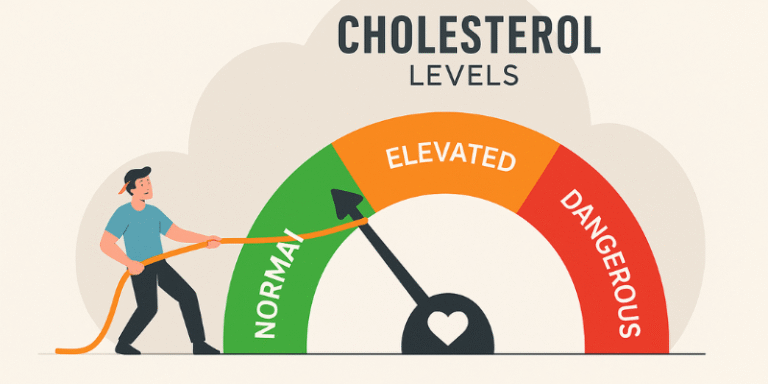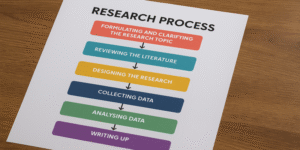Cholesterol is a substance that often provokes concern and confusion in public health discussions. It is commonly linked to heart disease and poor diet, yet it is also vital for the functioning of the human body. To understand cholesterol properly, it is essential to explore its biological role, types, sources, and implications for health, all while demystifying common misconceptions.
What is Cholesterol?
Cholesterol is a type of lipid — a waxy, fat-like substance that is insoluble in water. It is a sterol, a subgroup of steroids, and is crucial in maintaining the integrity of cell membranes, synthesising hormones such as oestrogen and testosterone, producing vitamin D, and generating bile acids which help in digesting fats (Maton et al., 1997).
The liver produces most of the cholesterol in the body, while the rest comes from dietary sources such as meat, dairy products, and eggs. Cholesterol is carried through the bloodstream by lipoproteins, as it cannot dissolve in blood on its own.
Types of Cholesterol
There are two major types of lipoproteins that transport cholesterol:
1.0 Low-Density Lipoprotein (LDL): Often labelled as “bad” cholesterol, LDL transports cholesterol from the liver to the tissues. If too much LDL cholesterol circulates in the blood, it can slowly build up in the walls of arteries, forming plaques that narrow and harden the arteries — a process known as atherosclerosis (American Heart Association, 2023).
2.0 High-Density Lipoprotein (HDL): Referred to as “good” cholesterol, HDL removes excess cholesterol from tissues and arteries and transports it back to the liver for excretion. A high level of HDL is associated with a lower risk of cardiovascular disease (Alaupovic, 2003).
There are also other forms such as Very Low-Density Lipoproteins (VLDL) and Intermediate-Density Lipoproteins (IDL), which carry triglycerides and contribute to plaque formation, though they are less discussed in general discourse.
Functions of Cholesterol
Despite its bad reputation, cholesterol plays indispensable roles in the body:
- Cell Membrane Structure: Cholesterol is integrated into cell membranes, helping to maintain fluidity and permeability (Nelson & Cox, 2017).
- Hormone Production: It is a precursor for all steroid hormones, including cortisol, aldosterone, oestrogen, and testosterone.
- Vitamin D Synthesis: Cholesterol in the skin is converted into vitamin D when exposed to ultraviolet B (UVB) rays from the sun.
- Bile Acid Formation: Cholesterol is converted into bile acids that assist in the digestion and absorption of fats (Guyton & Hall, 2016).
Dietary Sources of Cholesterol
Cholesterol is found in animal-based foods, including:
- Egg yolks
- Red meat
- Shellfish
- Cheese and butter
However, dietary cholesterol has less impact on blood cholesterol than previously believed. The focus has shifted to saturated fats and trans fats, which stimulate the liver to produce more cholesterol (McArdle et al., 2010). Foods rich in saturated fats, such as processed meats, pastries, and deep-fried products, contribute significantly to elevated LDL levels.
Health Implications of High Cholesterol
High blood cholesterol is a major risk factor for coronary heart disease, stroke, and peripheral vascular disease. When cholesterol accumulates in the arteries, it forms plaques that may rupture and cause blood clots, potentially leading to heart attacks or strokes.
According to the World Health Organization (2022), raised cholesterol levels are estimated to cause 2.6 million deaths annually. Cardiovascular diseases (CVDs), of which high cholesterol is a critical contributor, are the leading cause of death globally.
People with familial hypercholesterolaemia, a genetic condition, inherit high cholesterol levels regardless of their diet or lifestyle and are at greater risk of early-onset CVD (Goldstein & Brown, 2009).
Diagnosing and Monitoring Cholesterol Levels
Cholesterol levels are measured through a lipid profile, a blood test that includes:
- Total cholesterol
- LDL cholesterol
- HDL cholesterol
- Triglycerides
According to NHS guidelines (2023), desirable blood cholesterol levels for healthy adults are:
- Total cholesterol: Below 5 mmol/L
- LDL cholesterol: Below 3 mmol/L
- HDL cholesterol: Above 1 mmol/L for men and 1.2 mmol/L for women
Managing and Lowering Cholesterol
There are several evidence-based strategies to manage cholesterol levels:
- Dietary Changes
Adopting a heart-healthy diet rich in fruits, vegetables, whole grains, and lean proteins can reduce LDL levels. Foods like oats, barley, and beans are high in soluble fibre, which binds cholesterol in the digestive tract and removes it (Mensink et al., 2003).
2.0 Physical Activity
Regular exercise increases HDL cholesterol and helps reduce LDL and triglycerides. The British Heart Foundation (2023) recommends at least 150 minutes of moderate activity each week.
3.0 Medications
For individuals at high risk of cardiovascular events, medications like statins are prescribed. Statins block an enzyme in the liver responsible for cholesterol production (Liao, 2005). Other drugs include bile acid sequestrants and PCSK9 inhibitors.
Misconceptions About Cholesterol
A common myth is that all cholesterol is harmful, but as shown, cholesterol is essential for life. Another misconception is that only overweight individuals have high cholesterol. In reality, genetics, age, and other factors also play a role.
It is also mistaken to believe that avoiding cholesterol-rich foods alone can drastically lower blood cholesterol. Instead, overall dietary patterns, especially the type of fat consumed, are more influential.
Cholesterol, while often viewed negatively, is a complex and vital substance in human biology. The key to good health lies in maintaining a balance — ensuring cholesterol levels are high enough to support essential body functions, but low enough to avoid atherosclerosis and cardiovascular complications. With awareness, regular screening, healthy lifestyle choices, and, if necessary, medical interventions, individuals can manage their cholesterol and safeguard their heart health effectively.
References
Alaupovic, P. (2003). Significance of apolipoproteins for structure, function, and classification of plasma lipoproteins. Methods in Enzymology, 263, 32-60.
American Heart Association. (2023). Understanding Cholesterol. Available at: https://www.heart.org/en/health-topics/cholesterol
British Heart Foundation. (2023). Cholesterol. Available at: https://www.bhf.org.uk/informationsupport/risk-factors/high-cholesterol
Goldstein, J.L. & Brown, M.S. (2009). The LDL receptor. Arteriosclerosis, Thrombosis, and Vascular Biology, 29(4), 431–438.
Guyton, A.C. & Hall, J.E. (2016). Textbook of Medical Physiology. 13th ed. Philadelphia: Elsevier.
Liao, J.K. (2005). Isoprenoids as mediators of the biological effects of statins. Journal of Clinical Investigation, 110(3), 285–288.
Maton, A., Hopkins, J., Johnson, S. et al. (1997). Human Biology and Health. Englewood Cliffs, NJ: Prentice Hall.
McArdle, W.D., Katch, F.I., & Katch, V.L. (2010). Exercise Physiology: Nutrition, Energy, and Human Performance. 7th ed. Philadelphia: Lippincott Williams & Wilkins.
Mensink, R.P., Zock, P.L., Kester, A.D. & Katan, M.B. (2003). Effects of dietary fatty acids and carbohydrates on the ratio of serum total to HDL cholesterol. American Journal of Clinical Nutrition, 77(5), 1146–1155.
Nelson, D.L. & Cox, M.M. (2017). Lehninger Principles of Biochemistry. 7th ed. New York: W.H. Freeman.
NHS. (2023). High cholesterol – Symptoms and causes. Available at: https://www.nhs.uk/conditions/high-cholesterol/
World Health Organization. (2022). Raised Cholesterol. Available at: https://www.who.int/news-room/fact-sheets/detail/cholesterol









